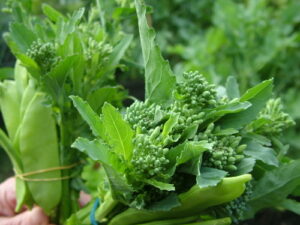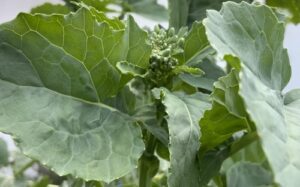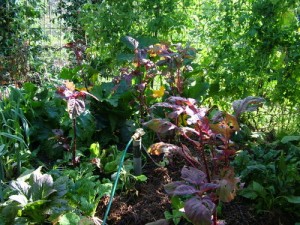I live smack bang in fruit fly territory. Bactrocera tryoni – Queensland Fruit Fly. They seem to be getting, if anything more prolific as the climate heats up, and I think over the years I’ve tried every known method of control, short of spraying, which I can tell without trying it wouldn’t work.
The pheromone baited traps catch lots of male flies, but it makes no real difference to the infestation. It probably just breeds dumber fruit flies. The protein baited traps catch lots of fruit flies of both sexes but there is so much rainforest fruit around, and other people’s gardens, that there’s a nearly infinite number where they came from. Pruning trees low and covering with a mosquito net works if you get the net on early enough, and it has no holes and goes all the way to the ground. But nets only last one season in the weather, and pruning means you have a small tree without a lot of fruit. Bagging each fruit with cloth, mesh or paper exclusion bags works if you get the bags on early enough, but it’s a huge amount of work. And if you can’t see through the bag, it’s hard to know when the fruit is ripe. Predators work, especially spider webs and insectivorous birds, but they just keep the population down, not out. Planting varieties that fruit very very early – October – used to work but seems to be less and less effective.
These days my best strategies are:
- Give up on the things that are really fruit fly prone – it’s just not worth the effort. So I’ve been cutting out the stone fruit trees, leaving just the tough skinned seedling peaches that have some resistance. I plant one or two rounds of beefsteak type tomatoes like Brandywine early, but for mid and late season tomatoes, I go for Roma and cherry types that are fruit fly resistant.
- Love spiders.
- Enjoy the fact that for home consumption, you can just cut fruit and eat the good half. It’s sometimes hard to tell from the outside. These cherry tomatoes, for example, all looked fine, and most were, but if I had been aiming to sell them, this one fruit fly infested one would have made the whole lot unsaleable. My peaches are often stung but I can cut out the stung part for the chooks, and put the rest in the fruit salad.
- Allow chooks, ducks and geese to forage below fruit trees. They clean up fallen fruit and like the fruit fly infested ones best. Pick fruit fly infested fruit and feed to the enclosed chooks. This breaks the breeding cycle, but there’s an infinite supply breeding in the native figs and wild fruit, so it doesn’t make any serious impact on populations. It does, however, turn a waste into a resource.
So breakfast for my chooks today was a bucket of stung Bishops Crown chilis and a bowl of stung tomatoes, and breakfast for me was toast with the one last of the brandywines, miraculously unstung, and everyone is happy.





How do your chickens feel about chilies? And why does everyone in Australia call them chooks?
Jenny
Hi Jenny, they loooove chilis. I think all birds do. I think I read somewhere that it’s a plot by chilis to get their seeds dispersed. And in Australia, chickens are baby chooks, like lambs are baby sheep.
See, the chillies never get fruit fly here, but the tomatoes are rubbish unless we grow them in winter (which sometimes works). And the nectarine and peach are basically useless. We live in a suburb surrounded by old Italians and their fruit trees, and the bugs are everywhere! 🙂 Why do you think the traps lead to dumber fruit flies? I thought the smarter ones wouldn’t get caught?
You would be towards the south of the Queensland fruit fly range, but Sydney is well within it I think. Try cherry and Roma varieties of tomatoes. They are much more resistant. The pheromone baits are based on female fruit fly hormones, and I guess would attract the alpha males, so perhaps i mean less James Bond!
I guess the benefits of living in a state where petrol costs 15c+ more than the mainland and everything is more expensive is that we don’t have fruit fly. Your ethos is exactly what I am trying to convince myself is MY ethos…our possums and wallabies might not be as tiny as your fruit flies but they can do more damage in a night than a fruit fly with free reign can do in a year. I am in the process of creating a food forest with the intentions of attempting to live harmoniously with the natives…I think gardening sustainably has to include a tithe to the natives 😉
Fortunately or unfortunately I have possums and wallabies too, and brush turkeys and cockatoos and king parrots and bower birds and….
Tithing is all very well, but they all have no notion whatsoever of sharing. If it’s there, it’s theirs. And the cockatoos in particular have never had a nanna telling them that wasting food is bad – they take one big bite out of a lemon and leave the rest on the ground. These days I have to fortress fence my garden. It’s an interesting dilemma. I think food producers can also be wildlife warriors only in places where previous generations have so decimated the wildlife that they only need to share with it in principle, not in practice! Living in harmony with wildlife is complex and nuanced, very worth it, but not easy.
Fruit fly are a pain. I have begun netting my trees with a ‘VegeNet’ from Greeharvest. They are big enough to keep the tree at a good size and the last for many seasons so the price is good. The extra bonus is they keep birds and possums out too. I got a great peach crop and then took the nets off the peach trees and put them on the apples. Interestingly the fruit fly get into the peaches early but don’t really bother the apples until they are nearly ripe. It makes me keep the trees well pruned and each year I will buy a few more until I have enough for all my trees.
Thankfully we don’t have fruit flies over here – we have enough trouble with slugs and snails.
I have picked my tomatoes green this year and ripened them indoors. I think the taste is maybe a bit blander than vine ripened but at least I do get them. We have netted fruit trees in the past but then caught a fruit bat in one because the net was not tight enough. I have tried bags over fruit but bats have eaten into the bags!! One win I had – tiny cheap teddy bears hung in the macadamia trees – cheap and the cockies didn’t like the furry things hanging there. When cockatoos are noisy there is nothing to worry about, but when they go quiet beware they are busy. Its a jungle out there. PS I now enjoy the winter blossoms on the fruit trees instead of the fruit.
I lost all my feijoas and alot of my tomatoes to fruit fly last year so I put all the stung fruit in a 50L plastic bucket in the the sun for months. I decided not to even risk one escaping from the chooks. I also encourage the chooks to free range round the feijoa in the evenings and have bagged up some fruits individually. The fruit in the mesh bags is growing far more slowly than the ones that are not bagged up.
So far this year we seem to be way down on fruit fly numbers but I know it’s too early to be overly confident.